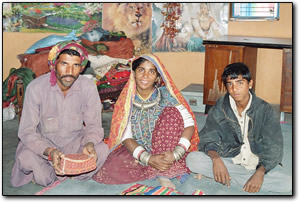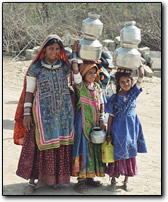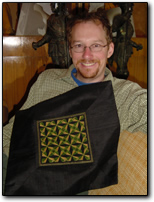
Kutch
We decided to travel straight across Saurashtra to Bhuj, the capital of Kutch. After looking over the transportation options, we decided that the best way would be by night bus. The bus looked comfortable. Above the seats were compartments with a mattress wide enough for two people, and long enough for us to stow our packs. The bed was comfortable enough, but the road was so bad that we were jostled and shaken violently all night long, making sleep impossible.
 |
 |
In 2002, the region of Kutch had been hit by a major earthquake that had destroyed most of the historic ancient city of Bhuj. Today there are still piles of uncleared rubble everywhere. Many of the surviving historic buildings were cleared away to make new wide streets through the old town. Only a few of the ancient city gates are being repaired at a speed even slow for India. The countryside fared better. Most of the people who lost their home quickly found shelter and soon NGOs arrived to build new, environmentally compatible dwellings. In fact so many houses had been built in the aftermath that many people now possess two or three. In their haste to act quickly, dwellings were built in areas where people did not want to live. Today they still stand empty.
 |
 |
In Bhuj we visited the palace of the Raj. Inside is a hall of mirrors called the Phul Mahal ( Flower Palace ) where indoor pools of water were built to combat the scorching summer heat. The entire building is badly damaged and has still not been restored. The people of Kutch (and Bhuj) were genuinely friendly, open, warm, helpful and hospitable. We rented a motorcycle and spent three days is the nearby desert, near the Pakistani border, visiting craft villages. The inhabitants are a mixture of tribes and religions. One night we slept with Muslims who lived in round mud huts with thatched roofs. They cooked us food and gave us beds. Two of the boys in the family were about to get married. They proudly showed us the presents, clothes and jewelry that they had prepared for the wedding. The region of Kutch is known for its crafts, especially embroidery. From the geometric designs of the Jats to the mirror work of the Rabhari, there is a wide range of styles. Unfortunately, most of what the individuals in villages had to sell was of very poor quality. There are several NGOs that promote local crafts and ensure that the artisans get a fair price for their work. We had much better luck finding good-quality embroidery at these places.
 |
 |
We rode up to a hilltop that overlooks the “Ran of Kutch”: the salt plains that separate India from Pakistan. A recently refurbished temple provided pilgrims' quarters where we could spend the night. Inside the kitchen, Anne learned how to roll and cook chapatis. The woman who baked them could roll them all out to precisely the same size and thickness. When all of the chapatis were ready, the guests lined up sitting on the floor with their metal plates to eat and socialize. The next morning, as we rode down a lonely road in the desert, we were fortunate to see some Asiatic wild ass running over the desert plains. Despite spending more than a week in Kutch, we felt that we had only scratched the surface. Everywhere we met interesting and genuine people who had plenty of time to talk: villagers, people working for NGOs and even the uncle of the current Raj who had just written a book about the area.
 |
 |
In most of the villages we were welcomed with shy stares or the occasional hello. Only a few villages had suffered from the visits of too many tour groups. At one place, the site of traditional mud-painted huts, we were greeted by a swarm of children asking for pens, candy, money and shampoo. Some of them tried to sell us cheap, shoddy crafts. They were so aggressive that we left immediately. Unfortunately this kind of behavior is present everywhere in India where too many tourists had visited. We never gave “presents” to children who just asked.
 |
 |
